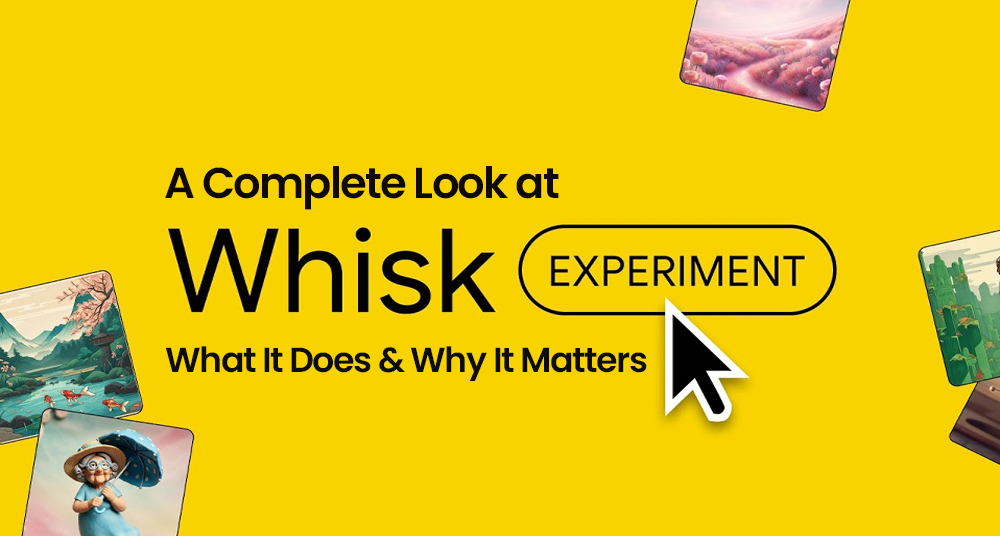In December 2024, Google launched Whisk, an experimental AI tool under Google Labs that reimagines how we create visuals. Unlike traditional image generators driven by purely textual prompts, Whisk AI lets you upload images for subject, scene, and style. The AI then analyzes those visuals using Gemini, writes a descriptive caption, and passes it to Imagen 3 to generate new, remixable images.
Whisk is designed for rapid visual exploration, where outputs capture the “essence” of inputs rather than strict replication. While still experimental and regionally limited, its approach offers a fresh kind of creativity that empowers both artists and casual users.
In 2025, Whisk AI represents a leap in generative AI—towards visual remixing, intuitive inputs, and creative freedom.
How Whisk AI Works: The Remix Approach
Whisk’s design fundamentally shifts the prompt process from text to images. The workflow proceeds broadly in these steps:
Upload three reference images
- Subject: the main object or character
- Scene: the background/environment
- Style: the artistic aesthetic, e.g., watercolor, cartoon, photorealistic
Automatic captioning via Gemini
Whisk uses Google Gemini’s vision / language model to analyze the three images and generate a descriptive caption that captures the essence of the inputs.
Image generation via Imagen 3
The generated caption is fed into Imagen 3, Google’s advanced image synthesis model, which crafts new images that blend subject, scene, and style.
Remix & refine iterations
Users can remix, tweak, or refine the prompt (adjusting caption, input images, or style weights) to explore multiple variations.
Because Whisk AI extracts only key characteristics—not pixel-perfect detail—it produces outputs that interpret rather than replicate inputs. This leads to creative variations and surprises.
Also, Whisk includes a “dice” icon feature that can generate random image prompts automatically if a user lacks reference images.
Whisk is still experimental, available via Google Labs in certain regions (initially the US).
Key Features of Whisk AI (2025)
Here are the standout features that make Whisk interesting and distinct:
Image-Based Prompting
Unlike most AI image tools relying on lengthy textual descriptions, Whisk uses images (subject, scene, style) as the core input. This lowers the barrier for users who struggle to express visual ideas in words.
Gemini-Driven Caption Generation
Whisk AI smartly uses Gemini to analyze the visual inputs and produce internal captions. This means the system translates visual cues into language before feeding them to Imagen.
Imagen 3 Integration
The powerful image generation happens using Imagen 3, allowing the AI to synthesize new visuals that merge style, content, and creativity.
Remixing & Iterative Exploration
Whisk allows you to remix combinations, iterate, and refine step-by-step, making it ideal for brainstorming varied visual ideas.
Preset Styles & Templates
Whisk currently supports style presets like sticker, plushie, enamel pin, etc.
Dice / Random Prompt Feature
If users don’t have reference images, Whisk can auto-generate suggestions via the “dice” button.
Refinement / Caption Editing
After generation, you can edit the internally generated caption or tweak prompt elements to refine results.
Rapid Visual Exploration
Whisk AI is designed for speed and experimentation—see many variations quickly, iterate, and explore ideas without deep technical input.
Educational / Classroom Support
Whisk is already being used by educators to assist students with art projects, visual storytelling, and concept development.
Benefits of Whisk AI (for Creators, Businesses, Students)
For Creators & Artists
- Idea incubation: Easily generate visual variations to spark new concepts.
- Reduced friction: No need to master prompt engineering from scratch.
- Experimentation friendly: Try bold combinations without heavy commitment to one design.
For Designers & Marketers
- Mockups & prototyping: Quickly mock product visuals (stickers, pins, apparel) based on style.
- Campaign visuals: Generate fresh imagery for marketing campaigns without stock dependencies.
- Creative mood boards: Use image remixing to explore visual direction.
For Educators & Students
- Visual storytelling: Translate essays or narratives into visual pieces to aid learning.
- Art education: Teach style blending and visual design via AI-assisted artworks.
- Project support: Rapid visual aids for presentations, assignments, etc.
For Businesses & Brands
- Brand extensions: Create merchandise mockups, style variations, or packaging designs.
- Customization at scale: Offer visual customization (e.g. personalized products) more easily.
- Visual content on demand: Reduce reliance on external designers for early-stage visuals.
Use Cases & Examples (2025 Edition)
Use Case 1: Merchandise Design
A brand launches a new enamel pin line. Using Whisk AI, they upload a product photo (subject), select a style (e.g. enamel art), and a scene (minimal background), then generate multiple variations. They pick the best, refine, and export for manufacturing.
Use Case 2: Social Media Campaign Visuals
A travel account wants a stylized image combining a destination photograph (scene) with a logo (subject) in a specific artistic style. Whisk instantly produces multiple campaign visuals ready to post.
Use Case 3: Educational Content
A history teacher asks students to upload ancient temple images, assign a style (sketch, watercolor) and a scene context. Students generate stylized visuals to accompany essays.
Use Case 4: Logo / Brand Concept Ideation
Designers upload a rough sketch (subject), a mood image (scene), and a style reference. Whisk AI gives refined concept versions to choose from and iterate further.
Use Case 5: Visual Prototyping for Apps / UIs
UX teams generate backgrounds or icon styles by combining component images, style references, and UI context, letting Whisk visualize future design direction.
Challenges, Limitations & Ethical Considerations
- Not pixel-precise: Whisk AI is built for experimentation, not exact reproduction of inputs.
- Regional availability: As of now, Whisk is limited (initially US) via Google Labs.
- Artistic inconsistency: Some outputs may distort proportions or diverge from expected style.
- Intellectual property concerns: Remixing images may raise copyright/privacy issues.
- Commercial usage clarity: There is some ambiguity about commercial use of AI-generated outputs via Whisk.
- Dependence on input quality: Good reference images matter; poor input leads to weak outputs.
- Bias & hallucination: AI may hallucinate artefacts or biased elements in outputs.
Given these, Whisk is best approached as a creative assistant—not a final production tool. Use it for ideation and prototyping, then refine further with human design.
Future Outlook for Whisk AI in 2025 and Beyond
- Global rollout: Expansion beyond initial regions to more countries.
- Text + image hybrid prompts: More flexibility to combine text hints with image inputs.
- Better control & weights: Allow users to emphasize certain input features or subtract others.
- Higher fidelity outputs: Improvements in resolution, detail, and realism.
- Animation / motion: Tools to animate visuals created with Whisk AI. (Some sources mention an “animate” capability)
- API / developer access: Let businesses integrate Whisk remixing into apps and services.
- Ethics & copyright guardrails: More robust guidance on usage, attribution, and rights.
As Whisk evolves, it may become a standard tool for quick visual prototyping across industries, especially for creative-minded teams.
Final Thoughts
Whisk represents a bold step forward in generative AI—one where images become the prompt, not just text. Rather than forcing ideas into rigid descriptions, Whisk AI lets creativity flow by allowing you to remix subjects, scenes, and styles visually.
Its combining of Gemini’s visual understanding with Imagen 3’s image synthesis delivers outputs that capture the essence of your inputs—not literal copies. This opens up tremendous potential for ideation, rapid prototyping, and visual exploration.
In 2025, its value will lie not in replacing human artistry but in accelerating creativity workflows: designers, marketers, educators, and creators can use Whisk as a playful sketchpad to explore many visual directions quickly. The ability to edit captions, remix inputs, and iterate gives it flexibility.
Of course, it’s still experimental—expect inconsistencies, surprises, and areas for improvement. But for those willing to experiment, it offers a glimpse of what visual AI can become: intuitive, expressive, and deeply collaborative.
Frequently Asked Questions (FAQs)
What is Whisk AI?
Whisk is Google’s experimental generative AI image tool that lets you remix imagery by uploading subject, scene, and style references.
How does Whisk AI differ from text-based image tools?
Instead of crafting textual prompts, Whisk uses images as input. Gemini captions transform them internally for image synthesis via Imagen 3.
Can I use Whisk-generated images commercially?
Official guidelines are evolving. Some references cite limited clarity around commercial use.
Why does my output look different than expected?
Whisk captures the “essence” of inputs—not exact copies. Users should iterate and refine inputs for better alignment.
Is Whisk available worldwide?
As of now, Whisk is in experimental release via Google Labs (initially in US). Broader rollout is expected.
Can I refine outputs after generation?
Yes — Whisk lets you edit the autogenerated captions or remix inputs to iterate visuals.
What use cases is Whisk good for?
Prototyping, campaign design, educational visuals, storytelling, merchandise mockups, and fast ideation.
Will Whisk replace traditional design tools?
Not yet. It’s best used for exploration and ideation. Final production often still requires human design refinement.
Related Blog: Microsoft Copilot Explained






What do you think?
It is nice to know your opinion. Leave a comment.